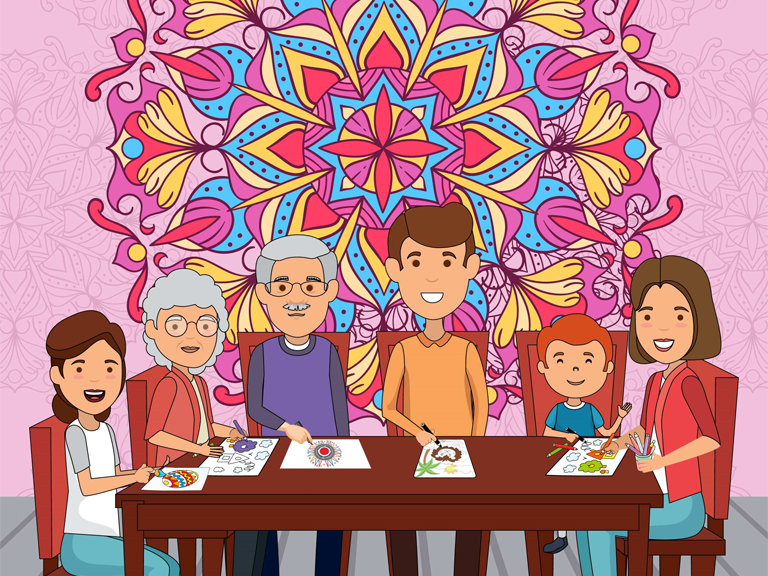How Classroom “Mandala Moments” Boost Attention and Emotional Regulation
Recent Blog
The mandala, a symmetrical diagram…
Family life often scatters generations…

Educators have long searched for low-cost, high-impact strategies to help students manage stress, maintain focus, and cultivate empathy. Recent classroom case studies suggest that “Mandala Moments”—five- to fifteen-minute coloring sessions inspired by Federico B. Cuadra’s A Complete Guide to Artistic Mandala Designs for Relaxation—are achieving precisely that. By merging simple art activities with structured breathing cues, teachers are witnessing measurable improvements in behavioral self-regulation and academic engagement.
The Science Behind Repetitive Visual Tasks
The neurological foundation is compelling. Research in neuroaesthetics shows that rhythmic, repetitive visual tasks engage the brain’s default mode network, the area involved in daydreaming, memory consolidation, and emotional processing. When students color symmetrical shapes, heart rates drop and cortisol levels fall, mirroring results often associated with mindfulness meditation. Yet, unlike seated meditation, coloring offers something tangible to restless hands, particularly useful for children with excess kinesthetic energy.
Setting Up A Mandala Moment
In typical implementations, a teacher projects a blank mandala from Cuadra’s sketch library onto a smart board or distributes individual printouts. The class collectively inhales for four counts, exhales for six, then begins coloring while soft instrumental music plays. The teacher remains silent or gently reminds learners to notice breath and color choices. After ten minutes, students jot a two-sentence reflection—“I chose blue and green because they feel calm”—before transitioning to the next lesson.
Observed Benefits in Focus
Teachers in three primary schools reported a 28 percent drop in post-recess disruptions after introducing daily Mandala Moments. Pupils who previously took eight to ten minutes to settle into math required only three. One educator noted that a student with ADHD, typically unable to remain seated, voluntarily stayed at his desk coloring and then completed the subsequent assignment without prompting.
Emotional Literacy and Peer Empathy
Beyond attention, the practice nurtures emotional vocabulary. Because color selections can reflect mood, teachers encourage discussion: “What did the warm reds represent for you today?” Students learn to articulate feelings indirectly, reducing the stigma of emotional transparency. Peer-to-peer conversations often include phrases such as “I chose grey because I felt tired,” fostering empathy among classmates.
Inclusion and Accessibility
Cuadra’s downloadable mandalas range from four-segment circles for younger or neurodivergent learners to intricate 32-segment designs that challenge older students. Graduation means that mixed-ability classrooms can participate simultaneously; no child feels left behind. Coloring also accommodates diverse language backgrounds—vital in multilingual settings—because calm is communicated visually rather than verbally.
Addressing Skepticism
Not all stakeholders embrace coloring as an academic activity. Some parents initially questioned “lost instructional minutes.” However, teachers presented comparative data: post-Mandala test scores improved by an average of six percentage points, likely because focused minds learn more efficiently. Administrators also discovered reduced behavior-referral paperwork, saving staff time.
Practical Tips for Implementation
- Consistency over duration – Daily five-minute sessions outperform sporadic twenty-minute blocks.
- Breathing first, color second – Establishes mindfulness before creative engagement.
- Reflection journaling – Two sentences anchor the experience in metacognition.
- Student choice – Allow learners to select designs and mediums (pencil, marker, digital tablet).
- Display finished work – Celebrated art reinforces ownership and pride.
Conclusion
Mandala Moments demonstrate that small, structured pauses can pivot a classroom from chaotic to centered. By aligning breath with color, students gain a self-regulation tool they can deploy beyond school walls—during exams, sports, or difficult conversations at home. For educators seeking a tried-and-tested blend of mindfulness and art therapy, Federico B. Cuadra’s methodology offers an accessible, scientifically grounded pathway toward calmer, more attentive learning environments.


